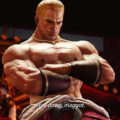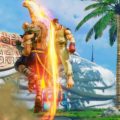Devil May Cry 2 “Retrospective” — Two-Faced

Much has been mentioned about Devil May Cry 2 in the nearly-19 years since its release, particularly about how bad it is. It’s all true.
DMC2 started development before the first game even reached store shelves worldwide, as decided by a Capcom that knew Devil May Cry would pave the way for a series. They had good foresight in retrospect; it’s the way the other team went about making the game where things went awry. Character designer and art director Daigo Ikeno mentioned in the Devil May Cry 3142 art book (the book’s artwork sections arranged in what used to be the canonical order — more on that later) that the team didn’t respect the vision of director Hideki Kamiya and the first game’s accompanying developers. It shows, especially given the reports over the years that Kamiya himself had no idea Capcom green lit the sequel until it was well under development, and was justifiably pissed off about it. But this is only part of the problem.
It would have been fine if a development team created their own interpretation on the DMC action formula if the result turned out good. It didn’t, though, and the final game left me wondering what the hell the team was even going for with it.

Let’s start with Dante himself, whose personality is so different here that he might as well be a different character. Dante in DMC1 took his plight against Mundus, Trish to a lesser extent, and his battle with a reincarnated version of his brother seriously, but wasn’t afraid to crack a joke every now and then. DMC2’s Dante is dead serious and only makes one sarcastic quip throughout the entire game, and his bizarre fascination for making decisions after the flip of a coin brings about comparisons to Batman villain Two-Face. It was weird, but it’s not like the stories and character development in any DMC game are anything to write home about. This would have been forgivable if the game itself was good.
It’s a shame, then, that DMC2 is pretty damned terrible. Dante’s fast and frenetic combat style from the first game is replaced with a slower style with attacks that lack substantial and necessary impact and player feedback. Not to mention the enemies themselves aren’t as fun to fight or defeat thanks to the drastically-lowered difficulty. I talked last week about how Dante’s guns were far more powerful in the first game, more important for combos compared to the melee-driven newer DMC games. But they’re extremely overpowered here. It’s possible, for instance, to take out several enemies and even bosses in good time without using any melee attacks. This sounds boring, but trust me when I say it’s even duller in action.

Needless to say, there’s an interesting story about this game’s behind-the-scenes development that’s still yet to be told nearly 20 years later. “Director” Hideaki Itsuno only took the lead chair in the last six years of development, to try and salvage the game in too quick of a time. Yet, Itsuno was the only one listed as the game’s director in the credits, which felt like a way to assign him with the blame for the game’s result. The person helmed it for most of its development remains unknown to this day. Ikeno’s aforementioned comments about the development team were nice, but there’s a full story here we don’t know. If it’s been a mystery after all this time, it’s tough to imagine we’ll ever get it.
I’ve hammered home how bad the game is enough here, but like plenty of other similarly dreadful experiences, there are good aspects of it. This game is still home to my favorite Dante design, and the other characters look good too. That’s thanks to Ikeno, one of the notable people on the team who admittedly respected the vision of the original game’s developers. At least the Dante design was used for a good game when Shin Megami Tensei III: Nocturne featured Dante from the Devil May Cry™ series. The soundtrack is good too, which has been overlooked thanks to being attached to this game.

For as much as Capcom likes to pretend DMC2 never happened, to the point of rearranging canon to have Devil May Cry 4 take place after it rather than before, not every element of this game was discarded for future installments — for better and worse. Cool features it added to Dante’s repertoire like wall running and targeting multiple enemies with pistols were kept for his alternating Styles in future games. Bloody Palace, a bonus mode where players focus solely on fighting enemies and finishing them in a short time, became a staple for the franchise after being established here. DMC2 was also the first installment to include a non-bonus playable character who wasn’t Dante with Lucia. Her combat style isn’t as deep as Dante’s, but she was a nice-if-slight change of pace. The installments made for HD platforms have similarly had non-Dante playable characters.
On the other hand, DMC2’s art direction is nowhere near as strong as the first game’s, which continued into the third game with its similarly drab environments, as both games at least partly occur in deserted metropolises. In fact, no game has had art direction on par with the first game’s since, though the HD platform games are very pretty. Perhaps one day, they’ll make another installment with similar art direction.
Enough about that, though. For the next post, I plan to write a bunch about the Devil May Cry title that served as a new beginning for the franchise. It will be a good one.





